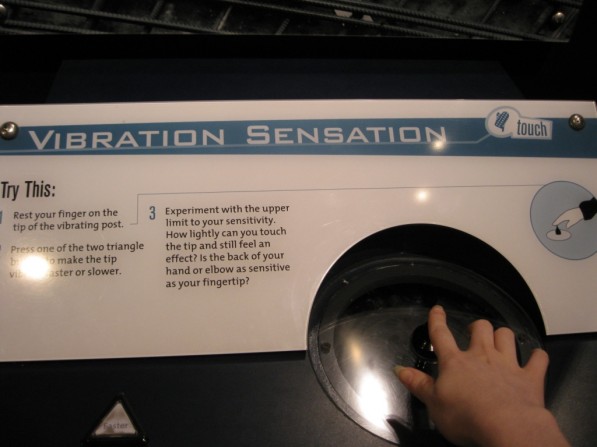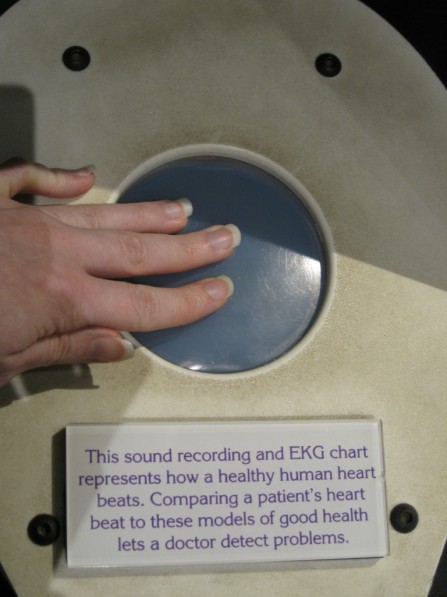CMME: Haptic Possibilities in Exhibits
Post written by: Marta Beyer, Peter Moriarty, Emily O’Hara, and Robert Rayle
Through the Creating Museum Media for Everyone (CMME) grant, the Museum of Science and several other institutions set out to explore various possibilities for developing accessible digital museum interactives. One particular area CMME allowed us to explore was the potential of haptics technology within museum settings. Haptics, the ability to get information from touch, present a promising and unique way to convey information. By sharing many of the lessons we learned about haptics in this series of blog posts, we hope the field can continue to discover possibilities connected with this technology. The first post below provides a quick overview of why we were interested in exploring haptics and some of the initial research we did for the CMME project. In a second post we describe some of the haptic methods we tried.
Project background and inspiration for haptics
With the CMME grant, we set out to consider how haptic technology could be used in a museum exhibit to provide information to audiences of all abilities. Specifically, we were trying to figure out how haptics could be incorporated into an accessible digital exhibit focusing on data exploration. As we started this project, we were aware that some museums currently incorporate basic haptic experiences to provide dynamic tactile feedback. For example, in the Museum of Science’s Take a Closer Look exhibition on senses there is a very basic tactile experience that includes a small vibrating post. By touching this post, visitors can gain a sense of how sensitive their skin is to different frequencies of vibration.

Photo of a visitor touching the vibrating post in a haptic interactive experience in the Museum of Science’s Take a Closer Look exhibition
Another haptic experience at the Museum of Science is in the Making Models exhibition, which highlights how people employ many different types of models to understand the world. One exhibit component, in particular, reveals several different ways humans model a heart, including a computer animation showing blood flow, a plastic model replicating the heart’s shape, a heart-shaped candy box, and words in different languages that convey the abstract concept of a heart. One model includes an audio representation of a heartbeat. Here visitors can also place their hand on the thin plastic sheeting which covers a speaker and feel the heartbeat through direct haptic feedback.

Photo of a visitor touching the haptic part of this exhibit component to feel the sonified heartbeat in the Museum of Science’s Making Models exhibition
Together, these exhibits encouraged us to think about even broader possibilities of haptics in museums and the potential to convey more complex ideas using touch.
Haptic resources
In addition to referring to these haptic exhibits, we also turned to other resources for haptic inspiration. The following list includes some of the most helpful resources we referenced.
- On this site industrial designer Camille Moussette shares his Ph.D. thesis on different forms of vibrational feedback. It explores a variety of haptic techniques such as shaking a whole unit, rotational vibrations, whacking vibrations, and some combination of these. For his dissertation, Moussette built different prototypes to document the processes and results. This reference provides a wide spectrum of ideas and inspirations and is a good starting point when making design goals and exhibit goals.
- This site is an in-depth exploration of specific haptic motors, in particular, ERM (eccentric rotating mass or pager motor style) and LRA (linear resonant actuators or voice coil style). It highlights the design choices one needs to think about when choosing between these different motor styles. It also walks someone through a design process of the whole system. Because this is a commercial site that sells motors, a designer could get information and specs about different systems which, in turn, could lead to him/her implementing a wide range of approaches.
- This non-profit organization provides access to haptic technologies. In particular, their site has specific products related to the Haptuator, or a specific vibrotactile device called a transducer. The output accelerations on these transducers allow one to distinctly feel vibrations in 50 Hz-500 Hz range. Because many different choices are provided, this site might be of use if someone is looking for a particular product or trying to decide whether or not specs meet their design parameters. Several articles are referenced in the “Related Publication” section on the site including those by Hsin-Yun Yao who’s Ph.D. thesis about vibrotactile transducers led to the creation of the Haptuator.
Stanford University Mechanical Engineering Course
- Information about Stanford’s Mechanical Engineering course called the “Design and Control of Haptic Systems” is provided on this site. Several papers/pdfs of relevant research are available. The lectures and assignments associated with this course could inform any technical designer’s haptics research and are quite inspirational. The “Haptic Interaction Design for Everyday Interfaces” article by Karon MacLean was particularly noteworthy for us as it describes basic information about haptics and relevant, current technology.
Haptics Group at the University of Pennsylvania
- This site provides an overview of haptics and describes how the Haptics Group is connected with the GRASP Lab at the University of Pennsylvania. It also links to Professor Katherine Kuchenbecker’s short but fascinating TED talk on haptics and some potential applications.
If you know of other haptic resources—please pass them along in the comments below!
by Marta Beyer ![]() on October 31, 2014
on October 31, 2014